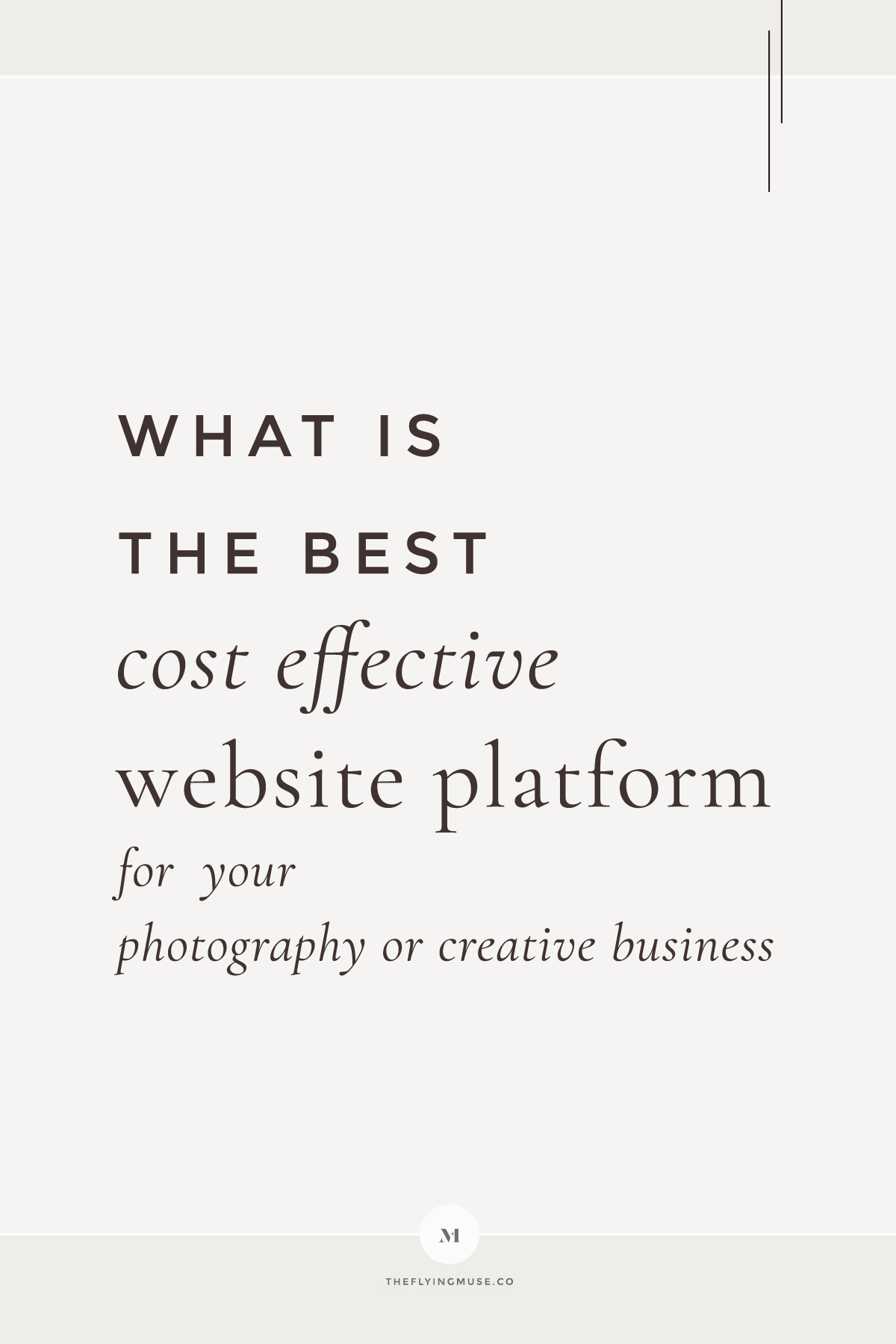What is the Best Cost Effective Website Platform for your Photography or Creative business
~ Updated ~ January 30, 2025 ~
You finally decided to start your photography or creative business. You are excited, got your legal name registered, and just thrilled to start marketing your services to potential clients. You realize everything is great, but how do you reach your potential and dream clients?
While maybe you got your photography or creative business the bare branding basics – a logo and business cards designed – just came to a conclusion – you need a website, too. After all, you want to get those dream clients to book you or buy a product from you, don’t you?
After all of the excitement and announcing your newly established photography or creative business to friends and family (and perhaps that nice neighbor of yours) not to mention you even passed some business cards somewhere along, too – your phone doesn’t ring and there are no messages in your inbox. This is the moment, you come to a conclusion – you need a website or online presence to reach more prospects and spread your message. So, you just need the inspiration to get started with your website, right?
At this point, you probably go to Pinterest, create a board for yourself start pinning like crazy, or start Googling around for information – what you need to get to launch a website for your photography, creative business, or as an entrepreneur. Suddenly, you are hit by multiple platforms’ information and you can admit you are a bit lost, aren’t you?
Luckily for you, I’ve designed and managed multiple worldwide branding and website design projects within my 15+ years of graphic design and website design career. To calm you down a bit – this is the most common challenge photography or creative business owners come across when they are trying to gather all information on what is the right website platform for their photography or creative business. To help you out, I’ve summarized and included info you need to know before deciding which one is right for you. Fret no more, here is the info you need – so, read on!
Blogger
To be honest, the most cost-effective website platform is Blogger, not to mention it is pretty easy to set up and maintain a website on the Blogger platform by Google. Blogger is suitable for people just starting out, but the main focus still remains – blogging. You can get a free account and start building a website with the Blogger platform in a few minutes. However, for the basic Blogger version, you get a URL address containing .blogspot.com at the end. Therefore, your web address will be https://yourname.blogspot.com – and you want that yourname.com address for your business, right?
If you decide to use Blogger as a website platform for your photography or creative business, make sure you go and purchase your own custom domain and configure the blog/website address to yourname.com domain. While you can get a domain name from the Blogger dashboard, I recommend buying your domain from a domain registrar, and not via Google. This will allow you to switch hosting providers, at any later point in time, without any issue at all. The added cost for a domain name can be anywhere between $10 to $30 per year.
If you only need a simple website and blog to maintain, Blogger can be a great solution for your creative business. However, despite being a low cost I wouldn’t recommend Blogger for professional photography business owners, as you will outgrow the platform in no time.

WordPress.com
WordPress.com gives your creative or photography business an easy-to-use and customize website. Similar to Blogger you get a .wordpress.com website address. If you’d like a simple website and you think there will be no extra needs for your business to grow, I suggest you at least upgrade to WordPress.com Personal plan. For more added control and customization to your website, the Business plan is great since you can have any custom theme and any plugins installed on this plan.
At the time of writing this post, the WordPress.com Personal plan costs around $50/year and includes free domain registration. Similar to Google’s Blogger I recommend getting your own domain name from a different domain name registrar. This will keep site transfers flexible at any later point.
Here is a link to the WordPress.com domain pricing.
Self-hosted WordPress
To get up and running with a WordPress self-hosted website you will need a domain name and hosting. These costs are yearly for domains and monthly or yearly for hosting, with domains around $20 and hosting at a minimum of $50. However, if you decide to get a self-hosted WordPress website and intend to manage, update and maintain the website yourself this comes with a learning curve. If you ever used WordPress.com you will be able to make updates via the self-hosted WordPress interface without a problem.
For both creative and photography business owners – WordPress will allow your business to grow. There are many plugins to choose from, themes already developed and most of what you want or will need at a later point, probably is already out there for you.
If, as a creative owner you’d like to get an e-commerce solution, you will be able to set up your online store anytime you want.
Photography business owners will have the pleasure to grow their website and if they choose to switch to ProPhoto or Showit (details on ProPhoto & Showit below) at any later point, the transfer will be a breeze. Of course, you don’t have to switch your self-hosted WordPress website to ProPhoto or Showit.
Additionally, a self-hosted WordPress website means you will be responsible for the website maintenance if anything goes awry or updates are needed. You can always hire someone to do this for you. However, you should be aware this may either add costs or take time away from working with clients or managing your business.
ProPhoto
ProPhoto runs on self-hosted WordPress and is built specifically with photography businesses in mind.
If you want your photography website built on ProPhoto you will need everything from the self-hosted WordPress + ProPhoto license (around $200, $249 – ProPhoto raised the license fee with the release of ProPhoto 7).
ProPhoto is widely used by professional photographers and was built specifically for photographers. However, keep in mind that ProPhoto releases new versions at an additional cost. While your license covers upgrades for the current version, the new ProPhoto version always comes at an additional cost. However, worth noting here is that the awesome team at ProPhoto always adds an earlier version upgrade license discount to upgrade to the new ProPhoto version.
Edit June 2023: Some time ago ProPhoto discontinued ProPhoto 7 and now offers only ProPhoto 8 which is a managed platform and includes hosting.
While ProPhoto is a great solution for photography businesses, the website-building platform is a bit complex if you haven’t built a website by yourself before. If you’d like to jump-start your photography business website, you can get a free (one of the free included designs that come with version 7 is designed by me) or paid design template (around $300 per premium template). Feel free to check my ProPhoto 7 and ProPhoto 8 template designs. Or, you can work with me 😊 on a completely custom ProPhoto website design created from scratch without the need to get a starter template. However, you will need a ProPhoto 8 subscription.
With the release of ProPhoto 7, there is a visual page builder available, which tremendously shortens the time to design and update your ProPhoto website. ProPhoto certainly became a complete drag-and-drop website design platform (one still needs to enter settings elsewhere in the platform), and with the release of the visual page builder in ProPhoto 7 seems they will be shifting in that direction. In ProPhoto 8 there are additional features introduced which make ProPhoto even more improved not only for design possibilities but for the full user experience.
While setting up your photography business with a ready-made ProPhoto design might work for you, you may still want to hire professional help to at least set up your website for you. If your budget allows for it, I recommend you get a custom-designed ProPhoto website for your creative or photography business.
Showit
Showit is a complete drag-and-drop website design platform, without the need to know any code at all. Since this is a managed platform, Showit comes at a subscription cost (either monthly or yearly) in 3 tiers. The first tier gives you the option to design a static website for your photography or creative business, a brochure-like website. With the second tier, you get a WordPress blog, while with the third tier, you are able to install custom plugins, too. However, bear in mind not all WordPress plugins are compatible with Showit.
If you’re unsure if Showit is the platform for your photography or creative business needs, I wrote a Complete Review on Showit which includes an extensive list of Pros and Cons, too.
The most awesome Showit feature is that the platform gives you complete creative design freedom. You can design and style however you want, and if you make sure you have used all of the correct settings on your Showit website you can get a responsive pixel-perfect website. Not to mention you can have a completely different visitor experience on desktop and mobile since Showit allows you to design for both separately.
If you want to jump on Showit but aren’t quite sure if you can design and set the website up all by yourself, I recommend starting with a theme (free or paid), since all themes include the settings needed for the design to work out of the box without an issue at all. You’ll just need to plug your content in, request domain name configuration and push the publish button.
You can also check my Showit template designs or if your budget allows you can work with a Showit website designer like me, to handcraft a unique website experience for your photography or creative business.
Squarespace
As a platform, Squarespace has pros and cons, too. Their interface is drag and drop, making it easy to update your website whenever you need to without touching the code at all. You don’t have to worry about maintenance, their team does this for you. However, Squarespace is built with bloggers and small business owners in mind.
While Squarespace can be great for a creative business owner, photography business owners need to be aware that Squarespace is not specifically built with photographers in mind. This means there are some cons and you will most likely hit a wall if you need some additional tools and features implemented on your website.
If you intend to integrate an e-commerce solution within your Squarespace website, keep in mind that only Stripe, PayPal business, and Venmo are supported. While some of you may use Stripe and are happy with their service, at the time of writing this post, Stripe is available for select countries only.
When it comes to Squarespace, one of the downsides for photographer business owners is no additional tools are built specifically for Photographers. Therefore, if for instance, you’d like to integrate any type of bookings via your website, these will have to be handled by a third-party service.
When it comes to the cost, the Squarespace website cost comes at around $200 for the basic package (e-commerce has added costs).
Shopify
Shopify is a great platform to build an online store (or a website) for your creative or photography business or as an entrepreneur. Setting up a store is a breeze, and their interface is pretty simple to use. While Shopify will cost you a bit more than getting an online store for your photography or creative business on WordPress, it will cut your maintenance costs.
The basic package starts at $29/month, but I recommend you get the $79 if your business picks up. This will get you some added features, like gift cards, abandoned cart recovery & advanced reporting.
If you want to grow your business (with an e-commerce aspect) and not worry about maintenance Shopify is the way to go. The Shopify App Store has many free or paid apps that will suit almost any business case. While Shopify is mainly a platform to build and maintain an online store, you can set up a portfolio section, and blog section, and even add some nifty tools, too. There is no discussion on the subject if Shopify is suitable for creative business owners.
However, when it comes to photographers, there seems to be a misconception out there Shopify can be used to build a website for photographers who only sell printables or downloads. Shopify has added tools that could suit any professional photography business – you can set up private galleries, get bookings via your website or do practically anything a photography business may need (some of these have added costs).
What would I recommend?
I love working with both ProPhoto and Showit. I have to admit I’m torn between the two of them. Both platforms have their own features and characteristics. The only thing that joins them together is making use of WordPress for your blog. If you go with either one most likely you will not regret it.
And, to summarize…
I really hope you reached the end of this post. If you did, thank you for reading the whole thing. I totally understand how frustrating getting your creative or photography business website up and running can be. Luckily, there are designers, just like me who went through the process multiple times, designed websites for clients across the globe and are able to share insight on the subject. So, I am really curious, have you found the perfect website platform for your photography or creative business?
save + share this post
~ About the Author ~

Sandra | the Flying Muse
Sandra is the founder and lead designer of the Flying Muse, a boutique artisan creative studio handcrafting timeless brands and websites for photographers and creative entrepreneurs.

6 responses to “What is the Best Cost Effective Website Platform for your Photography or Creative business”
Ah, this is so helpful! I really needed this when I was redesigning my site. I ended up going with WordPress since I wanted to be in control of the customization. I have a few friends who are in the rebranding stage for theirs, so I’m definitely going to share this with them. Thank you!
Hi Melissa,
I do agree WordPress is a great platform to design and build your website on. In addition to the control you mentioned, WordPress gives a great platform to grow and expand and by now can offer features for almost any business type.
Thank you for your comment 🙂
Sandra
This is a great list of options – Blogger really can be great for people who are bootstrappin’ it hard, but its limitations can be time-costly in the long-run.
Hi Hannah,
While Blogger can be a great starting point, as you also mentioned, one thing to have in mind is that the platform is not so flexible and doesn’t offer a lot of options to grow. However, I completely agree it is a great starting point and probably a great low budget option.
Thank you for commenting 🙂
Sandra
Thanks for the tips. I currently use Adobe Portfolio as it’s free with my CC account. It’s great for displaying content but not so much for blogging or other features.
I’ve heard good things about Wix. Any thoughts?
Hi Simon,
Thank you for commenting! I’ve heard good and bad things about Wix, but I never used it for any of my sites or client websites. One of the most negative things I’ve heard about Wix is the SEO part (seems Wix is not setup properly for SEO purposes) + there is no export feature to export your own content should you choose to move away from Wix. So, if you decide to move to a different platform, you will have to move every single page and blog post manually. Based on this information, I never considered Wix a professional platform to design and develop a website.
Hope this info is helpful, but feel free to let me know if you need any info or if there’s a way I could help.
Have a great day!
Sandra